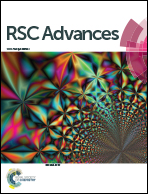Tetrathiafulvalene: effective organic anodic materials for WO3-based electrochromic devices†
Abstract
Finding a new, effective anodic species is a challenge for achieving simpler low-voltage tungsten trioxide (WO3)-based electrochromic devices (ECDs). In this work, we utilize tetrathiafulvalene (TTF) and demonstrate its reversible redox behaviors as an electrolyte-soluble anodic species. The concentration of TTF in the electrolyte is varied to optimize device performance. When the TTF concentration is low (0.01 M), a smaller maximum transmittance difference (ΔTmax ∼ 34.2%) and coloration efficiency (η ∼ 59.6 cm2 C−1) are measured. Although a better performance of ΔTmax ∼ 93.7% and η ∼ 74.5 cm2 C−1 is achieved at 0.05 M TTF, the colored state could no longer return to its original form. We conclude that 0.03 M of TTF is the appropriate concentration for high-performance WO3 ECDs with high optical contrast and reversible EC behaviors. The irreversible EC transition at high concentrations of TTF is attributed to the agglomeration of TTF molecules.



 Please wait while we load your content...
Please wait while we load your content...